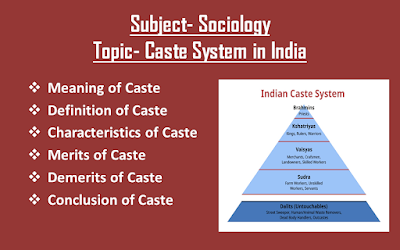Sanskritization- Meaning, Definition, Characteristics and Effects
# Meaning of Sanskritization
The term Sanskritization was first introduced by M.N. Srinivas the famous Indian sociologist in his book “Religion and Society among the Coorgs of Southern India” to describe the culture mobility in the traditional caste structure of Indian society.
In his study of the Coorgs in Karnataka region, he found that the lower castes have adapted the customs and values of the Brahmins in order to improve their position in the caste hierarchy.
There are three basic elements in Sanskritization. They are:
(a) Imitation:- The lower caste imitate the customs, value and behaviour patterns of the upper castes.
(b) Closeness:- The lower caste through Sanskritization come nearer to the upper castes. There is much change in social relations among various castes.
(c) Social mobilities:- Generally, Sanskritization helps the lower castes to move up in the social ladder. They share the status of the upper castes.
# Definition of Sanskritization
According to Srinivas:- “Sanskritization is a process by which a low Hindu caste or tribal or other group changes its customs, rituals, ideology and way of life in the direction of high, frequency, ‘twice born’ caste.”
# Characteristics of Sanskritization
1. Imitation:- The social status of an individual is fixed on the basis of caste hierarchy. There are many lower castes who suffer from economic, religious or social disabilities. So in order to improve the status, the lower caste people immediate the lifestyle of the upper caste people.
2. Twice-born caste:- Sanskritization is a process of culture change towards twice-born castes. Sanskritization is a process in which the lower castes adapt the culture patterns of the higher caste, to raise their status in the caste hierarchical order.
3. Social mobility:- Sanskritization is helpful in the social mobility of lower caste. In this process, a caste is only trying to change the status and not the social structure.
4. Followed by the tribal people:- Sanskritization process also followed by the tribal people. This process is not only confined to the caste people of Hindu society, it is also found among the tribal society.
5. De- Sanskritization:- The concept of Sanskritization has also given rise to de-Sanskritization. There are some instances in modern times, some of higher castes are imitating the behaviour pattern of lower caste, and for example Brahmins have started taking meat and liquor. This process is called De-Sanskritization.
# Effects of Sanskritization
1. Sanskritization in social field:- The social aspect of sanskritization is much more important from the view point of change. The lower caste individuals are inclined towards sanskritization because in that way they can elevate their social status and get higher status in caste hierarchy.
2. Sanskritization in economic field:- Economic betterment and sanskritization is another related issue. The lower caste people have given up un-cleared occupation to raise their economic status because clean trades are a symbol of social life.
3. Sanskritization in religious field:- Sanskritization also can be observed in the religious field. Like Brahmins, many of the lower castes people put on sacred thread. They also go to their temple regularly and perform Arti and Bhajan. They have left prohibited and un-cleaned occupation. Even they have specialized in performing ceremonies like Brahmins.
4. Sanskritization in living patterns:- The living patterns of lower castes have also Sanskritized. Like higher caste they also get Pucca houses built for them. Now they sit along with the higher caste on the cots without any fear or hesitation. They also keep their houses clean and put on dresses like higher castes.
# Sanskritization leads to only positional change and not structural change
It has been criticized for exaggerating social mobility or the scope of lower castes to move up the social ladder. For it leads to no structural change but only positional change of some individuals. Inequality continues to persist though some individuals may be able to improve their position within the unequal structure.
Mobility that is involved in the process of Sanskritization results only in “positional changes” for particular castes or sections of castes and need not necessarily lead to a “structural changes”. It means while individual castes move up or down, the structure as such remains the same.
Watch video on YouTube





